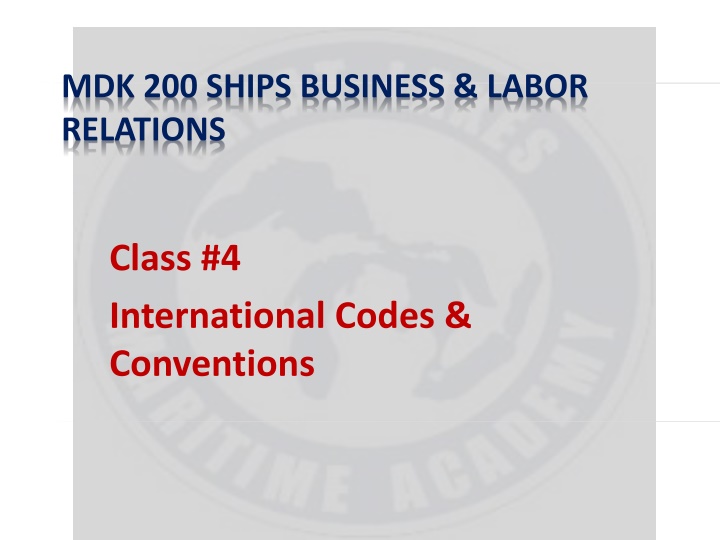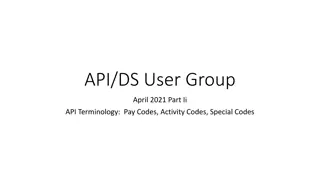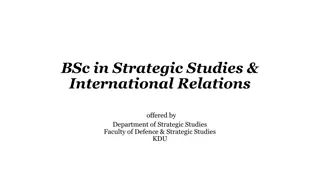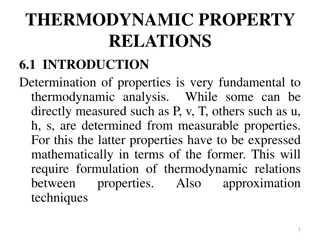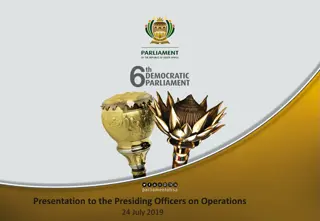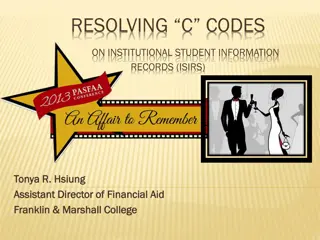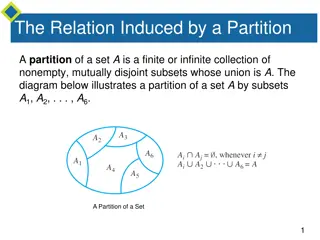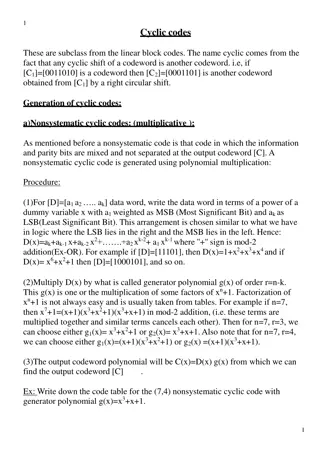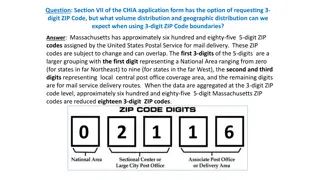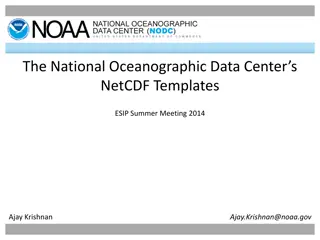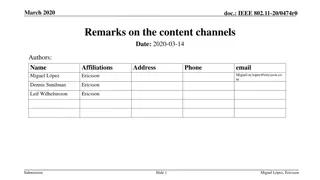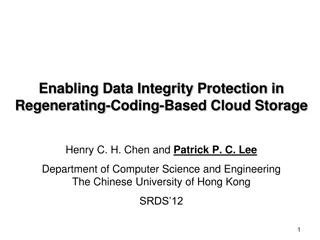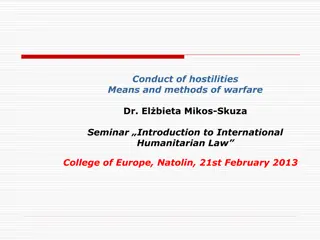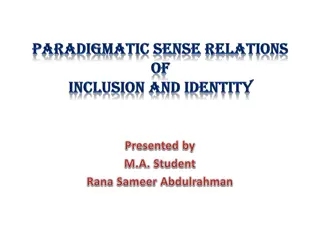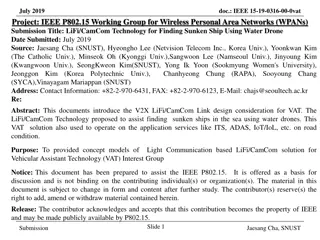International Codes & Conventions for Ships Business Relations
The International Convention for the Prevention of Pollution from Ships (MARPOL) covers various marine pollution violations under different annexes, with special areas designated for stricter regulations. Annex I focuses on oil pollution prevention regulations, including requirements for oil record books and emergency plans.
Download Presentation

Please find below an Image/Link to download the presentation.
The content on the website is provided AS IS for your information and personal use only. It may not be sold, licensed, or shared on other websites without obtaining consent from the author.If you encounter any issues during the download, it is possible that the publisher has removed the file from their server.
You are allowed to download the files provided on this website for personal or commercial use, subject to the condition that they are used lawfully. All files are the property of their respective owners.
The content on the website is provided AS IS for your information and personal use only. It may not be sold, licensed, or shared on other websites without obtaining consent from the author.
E N D
Presentation Transcript
MDK 200 SHIPS BUSINESS & LABOR RELATIONS Class #4 International Codes & Conventions
THE INTERNATIONAL CONVENTION FOR THE PREVENTION OF POLLUTION FROM SHIPS, 1973, MODIFIED BY THE PROTOCOL OF 1978 (MARPOL 73/78) MARPOL Covers all types of marine pollution violations, from misdemeanors to felonies. Each day a violation continues is considered a separate violation, Whistle-blowers may be entitled to up to half of the fines collected.
MARPOL IS COMPOSED OF FIVE ANNEXES. These provisions are codified throughout the CFR s They are not found as one coherent regulation.
MARPOL Some of the Annexes have designated special areas of the world where either no discharges are allowed or the restrictions on discharge are stricter than the annexes basic provisions.
ANNEX I REGULATIONS FOR THE PREVENTION OF POLLUTION BY OIL The particulars for compliance with Annex I can be found in 33 CFR 151.10. This section includes information on: Oily-water separators, Maximum oil concentration for overboard discharges, & The requirements of maintaining an Oil Record Book.
ANNEX IREGULATIONS FOR THE PREVENTION OF POLLUTION BY OIL Special areas for Annex I are listed in 33 CFR 151.13 include areas of the: Mediterranean Sea, Baltic Sea, Black Sea, Red Sea, Gulf of Aden, & The Antarctic area.
ANNEX I ALSO COVERS THE FOLLOWING: Shipboard oil pollution emergency plan requirements are outlined. Requirements for International Oil Pollution Prevention Certificates (IOPPs) can be found in 33 CFR 151.19 & Information of Shipboard Oil Pollution Emergency Plans (SOPEPs) is found in 33 CFR 151.26.
ANNEX II ANNEX II REGULATIONS FOR THE CONTROL OF NOXIOUS LIQUID REGULATIONS FOR THE CONTROL OF NOXIOUS LIQUID SUBSTANCES IN BULK SUBSTANCES IN BULK Annex II is codified in 33 CFR 151.30 This section lists applicability and certificates needed to carry various noxious liquid substances (NLS). It outlines the procedure for obtaining an attachment to an IOPP certificate for the carriage of NLS.
ANNEX II ANNEX II NOXIOUS LIQUID SUBSTANCES IN BULK NOXIOUS LIQUID SUBSTANCES IN BULK Special areas for Annex II listed in 33 CFR 151.32 include areas of: The Baltic Sea, The Black Sea, and Antarctic areas.
ANNEX III ANNEX III REGULATIONS FOR THE PREVENTION OF POLLUTION REGULATIONS FOR THE PREVENTION OF POLLUTION BY HARMFUL SUBSTANCES CARRIED BY SEA IN BY HARMFUL SUBSTANCES CARRIED BY SEA IN PACKAGED FORMS, OR IN FREIGHT CONTAINERS OR PACKAGED FORMS, OR IN FREIGHT CONTAINERS OR PORTABLE TANKS PORTABLE TANKS MARPOL Annex III is codified primarily in 49 CFR 171
ANNEX IV ANNEX IV REGULATIONS FOR THE PREVENTION OF POLLUTION BY REGULATIONS FOR THE PREVENTION OF POLLUTION BY SEWAGE FROM SHIPS SEWAGE FROM SHIPS These requirements are addressed by sections of the FWPCA (33 USC 1322) and are found in two places: USCG Regulations 33 CFR 159 and EPA Regulations in 40 CFR 140.3-4.
ANNEX V ANNEX V REGULATIONS FOR THE PREVENTION OF REGULATIONS FOR THE PREVENTION OF POLLUTION BY GARBAGE FROM SHIPS POLLUTION BY GARBAGE FROM SHIPS Special areas for Annex V lisled in 33 CFR 151.53 include areas of: the Mediterranean Sea, Black Sea, Gulf areas, Antarctic area, and Gulf of Mexico. Baltic Sea, Red Sea, North Sea, Caribbean region,
ANNEX V ANNEX V REGULATIONS FOR THE PREVENTION OF REGULATIONS FOR THE PREVENTION OF POLLUTION BY GARBAGE FROM SHIPS POLLUTION BY GARBAGE FROM SHIPS This annex is codified in 33 CFR 151.51 includes: Record keeping requirements, Waste management plans, Waste management placards, & Waste management inspection and reporting requirements. 33 CFR 151.51 and
ANNEX V ANNEX V DISCHARGE REQUIREMENTS AND DISTANCES OFF THE NEAREST LAND ARE AS FOLLOWS: 1.Plastics can never be discharged; they may be held aboard or incinerated. 2.Dunnage, lining, and packing materials that float must be discharged at least 25 miles from the nearest land.
ANNEX V ANNEX V DISCHARGE REQUIREMENTS AND DISTANCES OFF THE NEAREST LAND ARE AS FOLLOWS: 3. Food wastes and all other wastes including paper products, rags, glass, metal, bottles, and crockery must be discharged At least 12 miles from the nearest land. If the material has passed through a grinder it may be discharged outside a 3-mile distance from land.
ANNEX V ANNEX V GARBAGE DISCHARGE REQUIREMENTS GARBAGE DISCHARGE REQUIREMENTS 4.Mixtures of garbage having different requirements Must be retained aboard, or Discharged in accordance with the strictest applicable requirements.
ANNEX V ANNEX V GARBAGE DISCHARGE REQUIREMENTS GARBAGE DISCHARGE REQUIREMENTS No person may discharge garbage into the navigable waters of the United States. Plastic or garbage mixed with plastic may never be discharged into the sea or navigable waters of the United States.
ANNEX V ANNEX V GARBAGE DISCHARGE REQUIREMENTS GARBAGE DISCHARGE REQUIREMENTS Vessels must: Maintain a waste management plan. Maintain a waste management log Masters should endeavor to keep all records of garbage discharged ashore.
ANNEX V ANNEX V GARBAGE DISCHARGE REQUIREMENTS GARBAGE DISCHARGE REQUIREMENTS Subpart A Implementation of MARPOL 73/78 and the Protocol on Environmental Protection to the Antarctic Treaty as it Pertains to Pollution from Ships Sec. 151.55 Recordkeeping requirements.
ANNEX V ANNEX V GARBAGE DISCHARGE REQUIREMENTS GARBAGE DISCHARGE REQUIREMENTS (a) This section applies to the following: (1) Every manned oceangoing ship (other than a fixed or floating platform) of 400 gross tons and above that is engaged in commerce and that is documented under the laws of the United States or numbered by a State. (2) Every manned fixed or floating platform subject to the jurisdiction of the United States. (3) Every manned ship that is certified to carry 15 passengers or more engaged in international voyages.
ANNEX V ANNEX V GARBAGE DISCHARGE REQUIREMENTS GARBAGE DISCHARGE REQUIREMENTS (b) The master or person in charge of each ship under paragraph (a)(1), (a)(2), or (a)(3) of this section shall ensure that a written record is maintained on the ship of each of the following garbage discharge or disposal operations: (1) Discharge overboard. (2) Discharge to another ship. (3) Discharge to a reception facility. (4) Incineration on the ship.
ANNEX V ANNEX V GARBAGE DISCHARGE REQUIREMENTS GARBAGE DISCHARGE REQUIREMENTS (c) The record under paragraph (b) of this section must contain the following information on each discharge or disposal operation: (1) The type of operation as described under paragraphs (b)(1) through (b)(4) of this section. (2) The date and time of the operation. (3) If the operation was conducted at a port, the name of the port.
ANNEX V ANNEX V GARBAGE DISCHARGE REQUIREMENTS GARBAGE DISCHARGE REQUIREMENTS (c) The record under paragraph (b) of this section must contain the following information on each discharge or disposal operation: (4) If the operation was not conducted at a port, the latitude and longitude of the location where the operation was conducted and the estimated distance of that location from shore. If the operation involved off-loading to another ship, the identity of the receiving ship by name and official number. (5) The amount of garbage involved, described by volume in cubic meters.
GARBAGE GARBAGE DISCHARGE REQUIREMENTS DISCHARGE REQUIREMENTS (6) For discharges into the sea, a description of the contents of the garbage, described by the following categories: (i) Plastic material. (ii) Floating dunnage, lining, or packing material. (iii) Ground paper products, rags, glass, metal, bottles, crockery, or other similar garbage.
GARBAGE GARBAGE DISCHARGE REQUIREMENTS DISCHARGE REQUIREMENTS (6) Discharge into the sea, the garbage categories the garbage categories: (iv) Unground paper products, rags, glass, metal, bottles, crockery, or other similar garbage. (v) Victual wastes. (vi) Incinerated ash. (vii) Incinerated plastic residue.
GARBAGE DISCHARGE REQUIREMENTS GARBAGE DISCHARGE REQUIREMENTS (d) The record under paragraph (b) of this section: > Must be prepared at the time of the operation, > Certified as correct by the master or person in charge of the ship, > Maintained on the ship for two years following the operation, and > Be available for inspection by the Coast Guard.
INTERNATIONAL CONVENTION FOR THE SAFETY OF LIFE AT SEA INTERNATIONAL CONVENTION FOR THE SAFETY OF LIFE AT SEA (SOLAS) AND (SOLAS) AND INTERNATIONAL SAFETY MANAGEMENT CODE INTERNATIONAL SAFETY MANAGEMENT CODE (ISM) (ISM) In 1994 the ISM Code became: Chapter 9 of the SOLAS Convention Compliance is mandatory for signatory nations.
THE ISM CODE HAS THIRTEEN PARTS: 1. Introduction and General Explanation 2. Safety and Environmental Protection Policy 3. Company Responsibilities and Authority 4. Designated Persons 5. Master s Responsibility and Authority 6. Resources and Personnel 7. Development of Plans for Shipboard Operations
ISM CODE 8. Emergency Preparedness 9. Reports and Analysis of Non-Conformities, Accidents, and Hazardous Occurrences 10. Maintenance of the Ship and Equipment 11. Documentation 12. Company Verification, Review, and Evaluation 13. Certification, Review, and Control
STCW The STCW, as yet, does not apply to seafarers aboard: Warships, Vessels owned or operated by a signatory nation, Fishing vessels, or Pleasure yachts.
STCW Unlike the United States system of licensing (for officers) and certification (for unlicensed crew), The STCW code divides officers and crew The STCW code divides officers and crew into three levels: into three levels:
1. Management level: 1. Management level: Master, Chief Mate, Chief Engineer, and First Assistant Engineer
2. Operational level 2. Operational level: Officers in charge of a navigational or engineering watch, Designated duty engineers in unmanned engine rooms, & Radio Officers. This would be the equivalent of U.S. second and third mates and engineers.
3. Support level 3. Support level: Crew performing tasks under the supervision of persons at the operational or management level, The equivalent of U.S. unlicensed crewmembers
INTERNATIONAL LABOR ORGANIZATION (ILO) INTERNATIONAL LABOR ORGANIZATION (ILO) Founded in 1919, Now the International Labor Organization (ILO) is a part of the United Nations. This organization issues recommendations that are often adopted and incorporated into law by port states.
The ILO is an umbrella organization for all Labor Organizations A subdivision of the ILO is the: International Transport Workers Federation (ITF) Founded in 1896 An umbrella organization for over 650 independent Transportation Transportation Trade Unions in 148 countries. All modes of transportation are included ITF Seafarers Section ITF Seafarers Section represents mariners interests & Maritime Unions
U.S. FLAG SHIPS AND FOREIGN SHIPS OPERATING IN U.S. WATERS MUST COMPLY WITH VARIOUS ILO RECOMMENDATIONS SUCH AS THE FOLLOWING: 1. Safety standards, competency of officers and crew, work conditions, hours of work, and manning levels 2. Workers rights 3. Benzene level thresholds 4. Repatriation of mariners 5. Conditions of employment and shipboard living conditions 6. Safety of women at sea 7. Other recommendations affecting the safety and welfare of mariners
